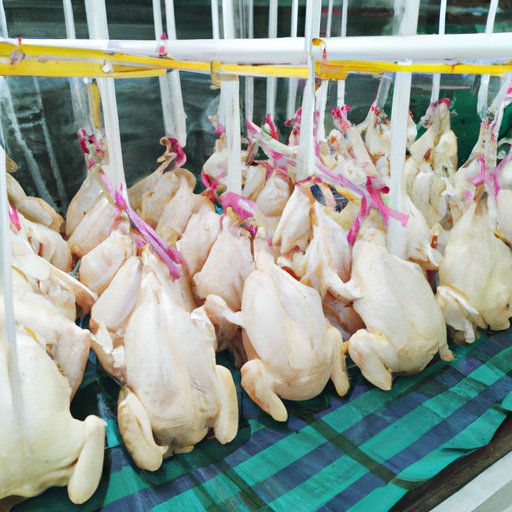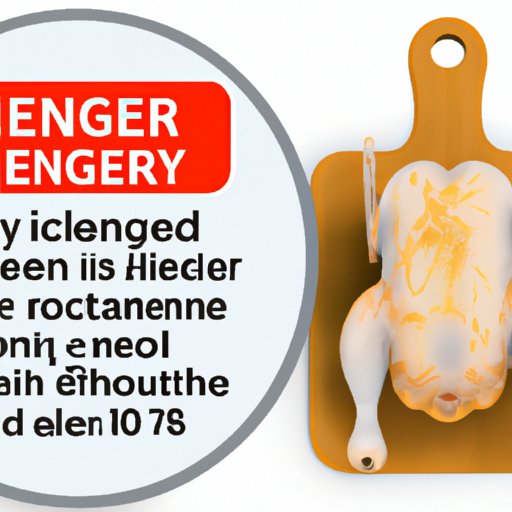
I. Introduction
Are you unsure of how long you can leave chicken out? You’re not alone. With busy schedules and distractions, it can be easy to forget to put away food items, including chicken. However, it’s crucial to prioritize food safety and understand the risks associated with leaving chicken unrefrigerated. In this article, we will cover everything from the danger zone for chicken, how to keep it safe, proper storage, simple rules to follow, the consequences of leaving chicken unrefrigerated, and more.
II. Food Safety 101: Understanding the Danger Zone for Chicken
It’s essential to understand the danger zone when handling chicken. Bacteria can grow rapidly between 40°F and 140°F, which is known as the danger zone. When chicken is left in this zone, bacteria can multiply to levels that can cause foodborne illness. Therefore, it’s crucial to keep chicken at the right temperatures to prevent bacteria growth.
III. The Truth About Leaving Chicken Unrefrigerated – How to Keep it Safe
It is recommended that chicken should not be left unrefrigerated for more than two hours. This time limit is even shorter in hot weather conditions. To keep chicken safe, it’s essential to handle it properly. Always wash your hands before and after handling chicken. Additionally, avoid cross-contamination by using separate cutting boards and utensils for raw chicken.
If you plan to leave chicken out of the fridge for a short period, it’s best to keep it covered to avoid contamination. The chicken should be kept in a cool area away from direct sunlight or heat sources.
IV. How to Store Chicken Properly to Avoid Spoilage and Contamination
If you have leftover chicken or plan to store uncooked chicken, it’s essential to store it properly to avoid spoilage and contamination. Raw chicken should always be stored in the refrigerator below 40°F. Chicken can be stored in the freezer for up to nine months, but it’s essential to package it properly to prevent freezer burn.
When reheating leftover chicken, it’s crucial to heat it thoroughly above 165°F to kill any bacteria. It’s best to consume leftovers within three to four days of storage.
V. 5 Simple Rules to Follow to Keep Chicken Fresh and Safe to Serve
To ensure that chicken is fresh and safe to serve, here are five simple rules to follow:
1. Separate raw chicken from other foods in your shopping cart, grocery bags, and refrigerator.
2. Clean all surfaces, utensils, and cutting boards thoroughly after handling raw chicken.
3. Cook chicken to the recommended temperature. For example, chicken breast should be cooked to an internal temperature of 165°F.
4. Use chicken before its expiration date. Always check the packaging for the sell-by date.
5. Refrigerate or freeze chicken promptly after purchasing or cooking.
VI. Why Leaving Chicken Out at Room Temperature Can Be Risky and How to Avoid it
Leaving chicken out at room temperature is risky because bacteria can grow rapidly, particularly during hot weather. To avoid this, only take out the chicken you need for immediate use. If you plan to serve chicken at a later time, keep it in the refrigerator until you’re ready to cook it.
Before cooking the chicken, allow it to sit out at room temperature for up to 30 minutes to ensure it cooks evenly. Always cook chicken immediately after it has reached room temperature.

VII. The Consequences of Leaving Chicken Unrefrigerated Too Long – Know the Risks
Leaving chicken unrefrigerated for too long can cause foodborne illnesses such as Salmonella, Campylobacter, and Listeria. Symptoms of these illnesses can range from mild to severe, including stomach cramps, fever, and diarrhea. In severe cases, hospitalization may be required.
VIII. Conclusion
In conclusion, it’s crucial to prioritize food safety when handling chicken. Understanding the danger zone and safe temperatures for storage and cooking can help prevent the risks associated with foodborne illnesses. Proper handling, storage, and cooking techniques can ensure that chicken is fresh and safe to eat. Follow these tips, and you can enjoy delicious chicken dishes without worrying about any health risks.




